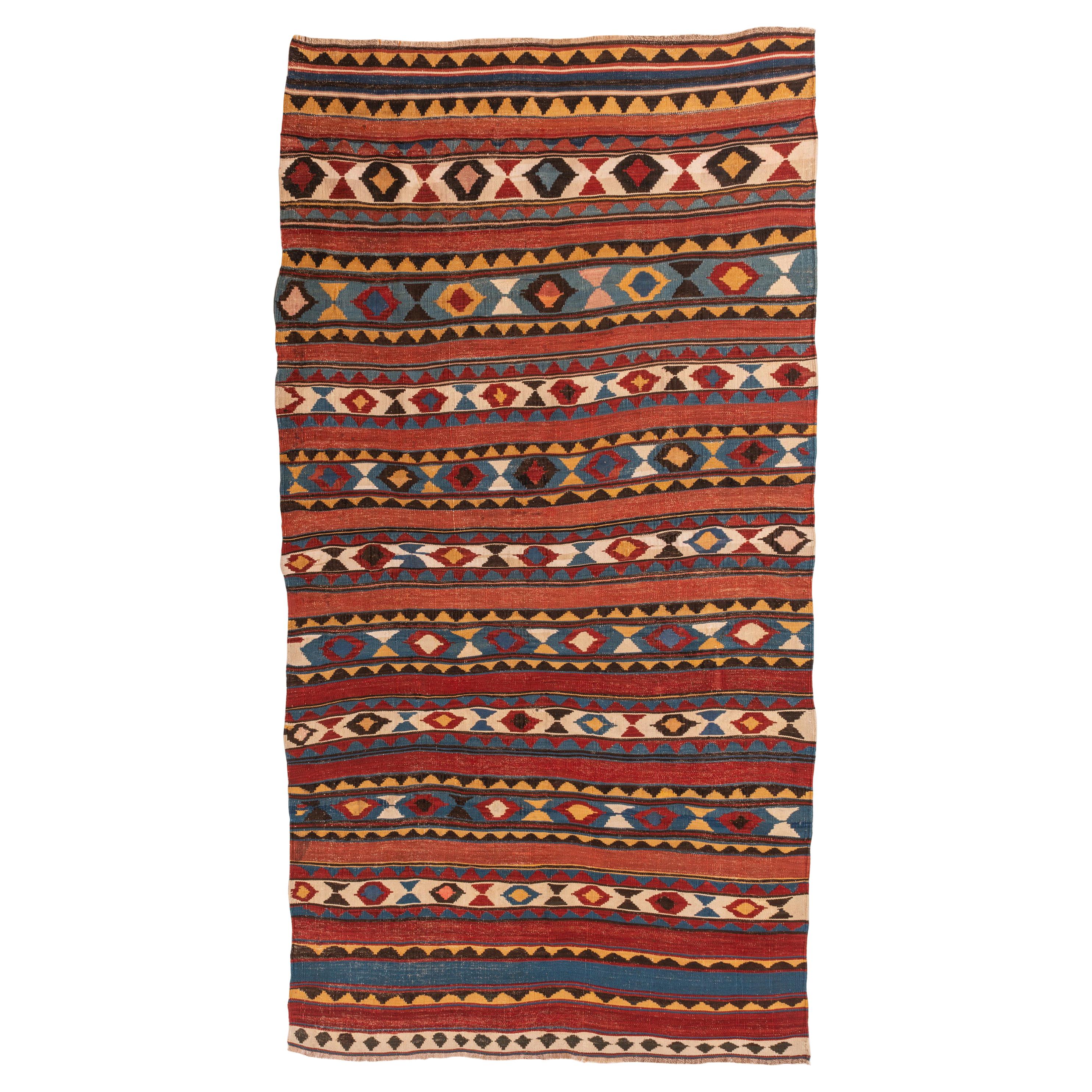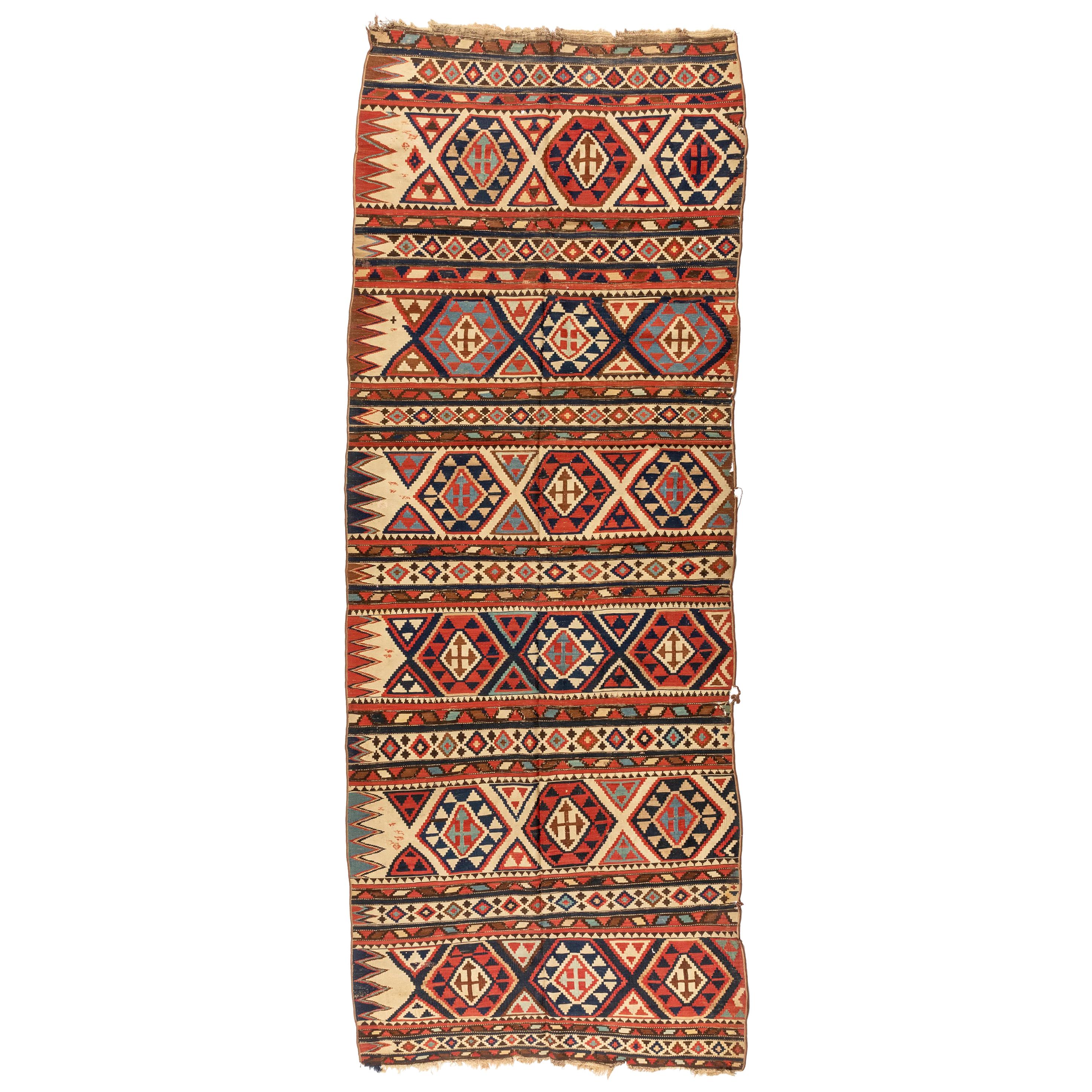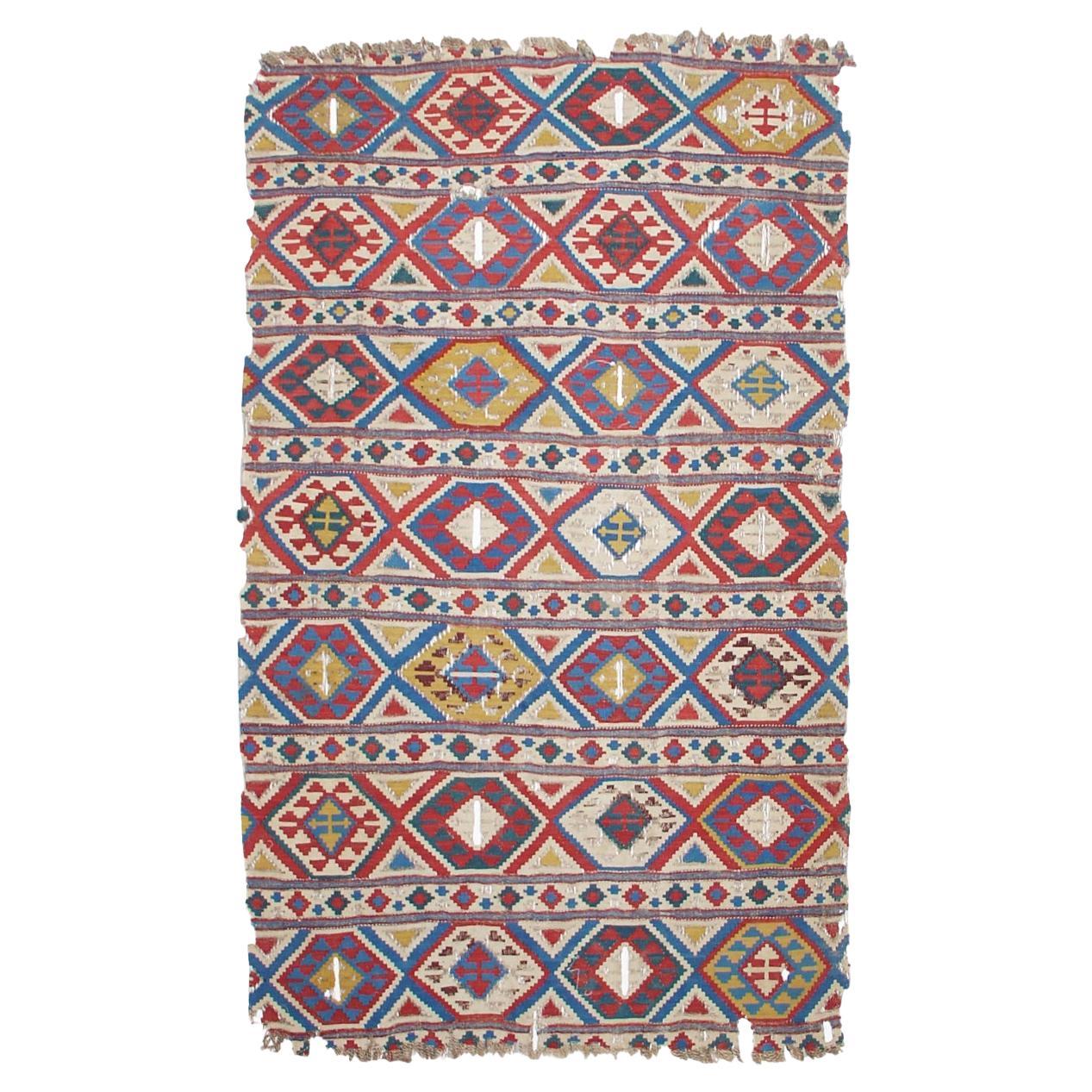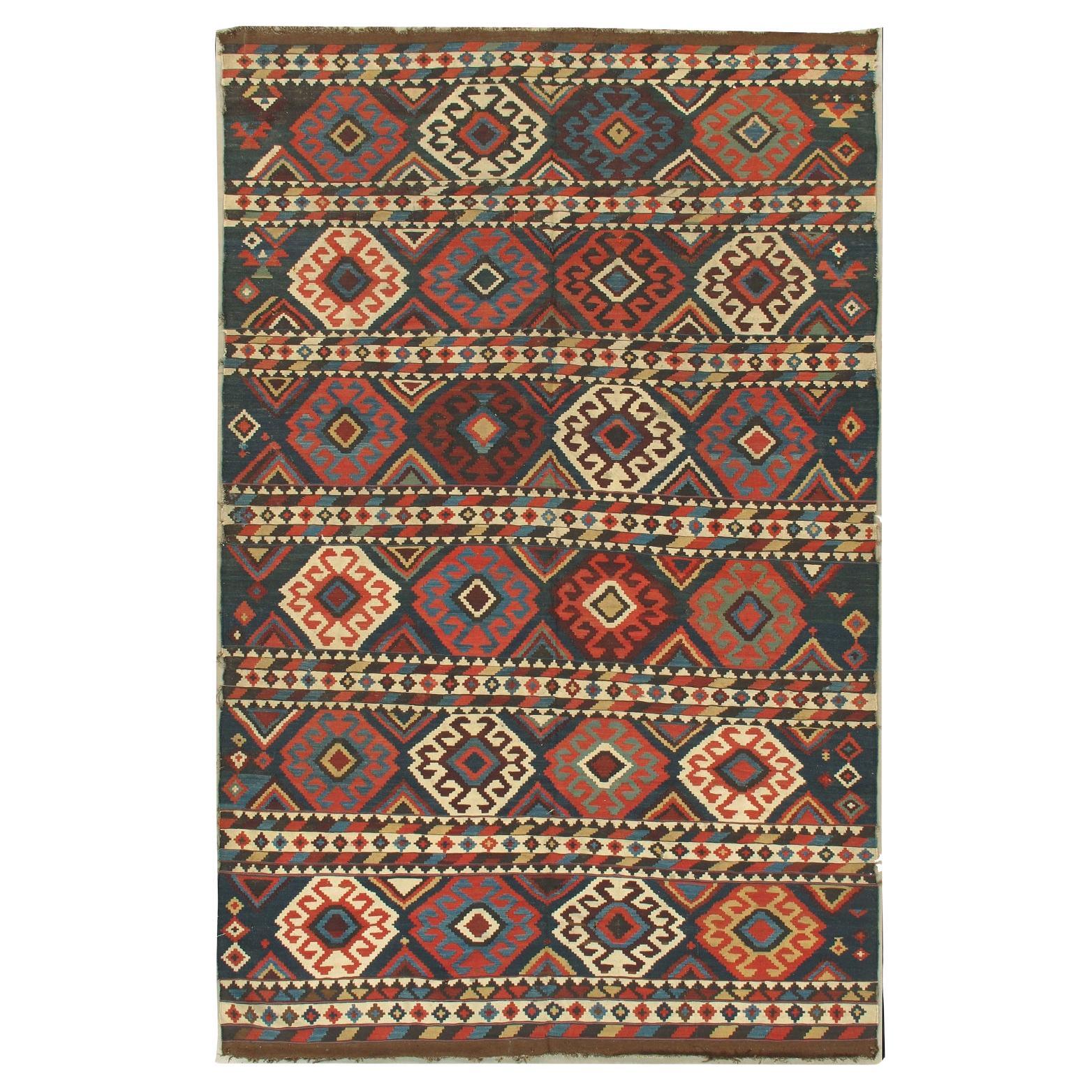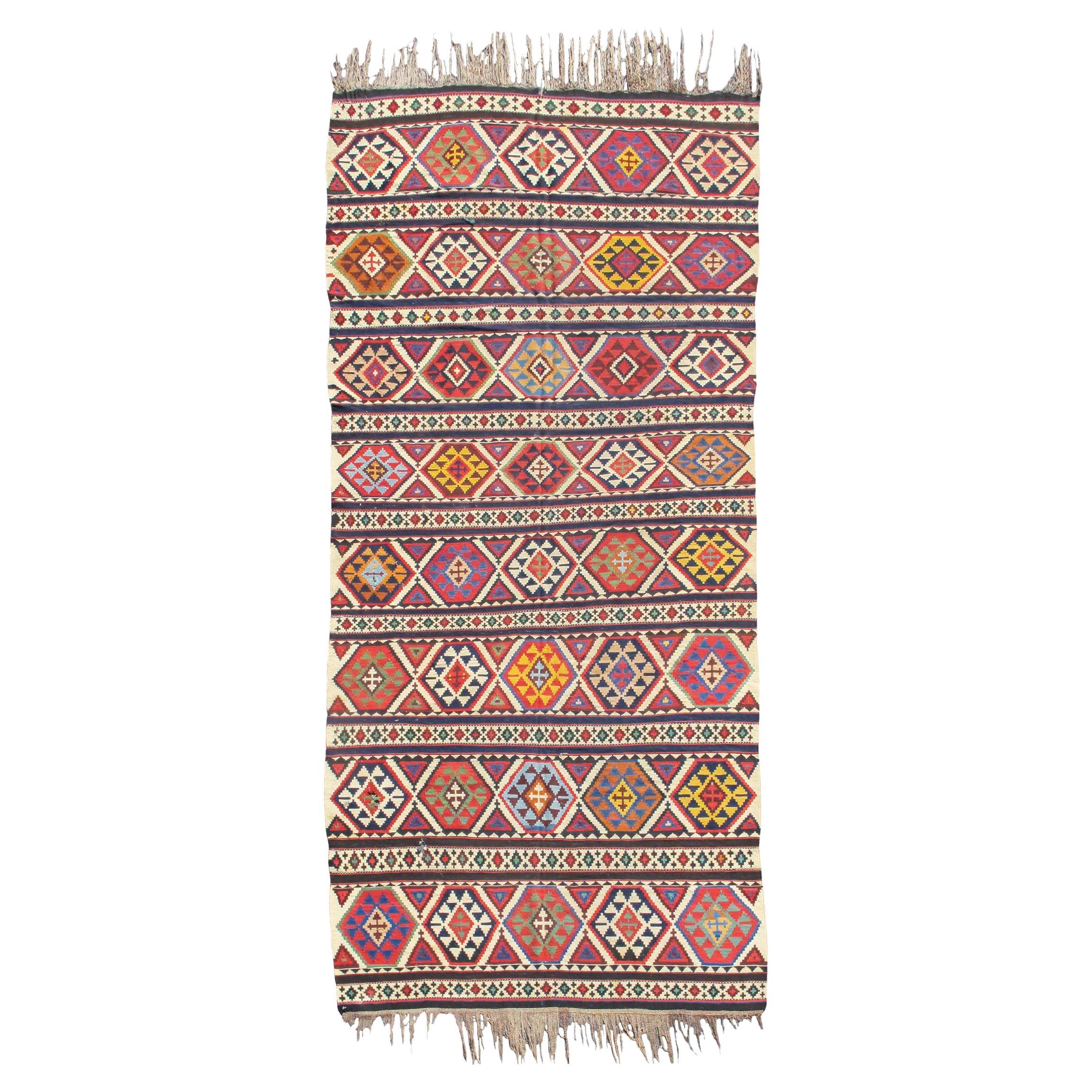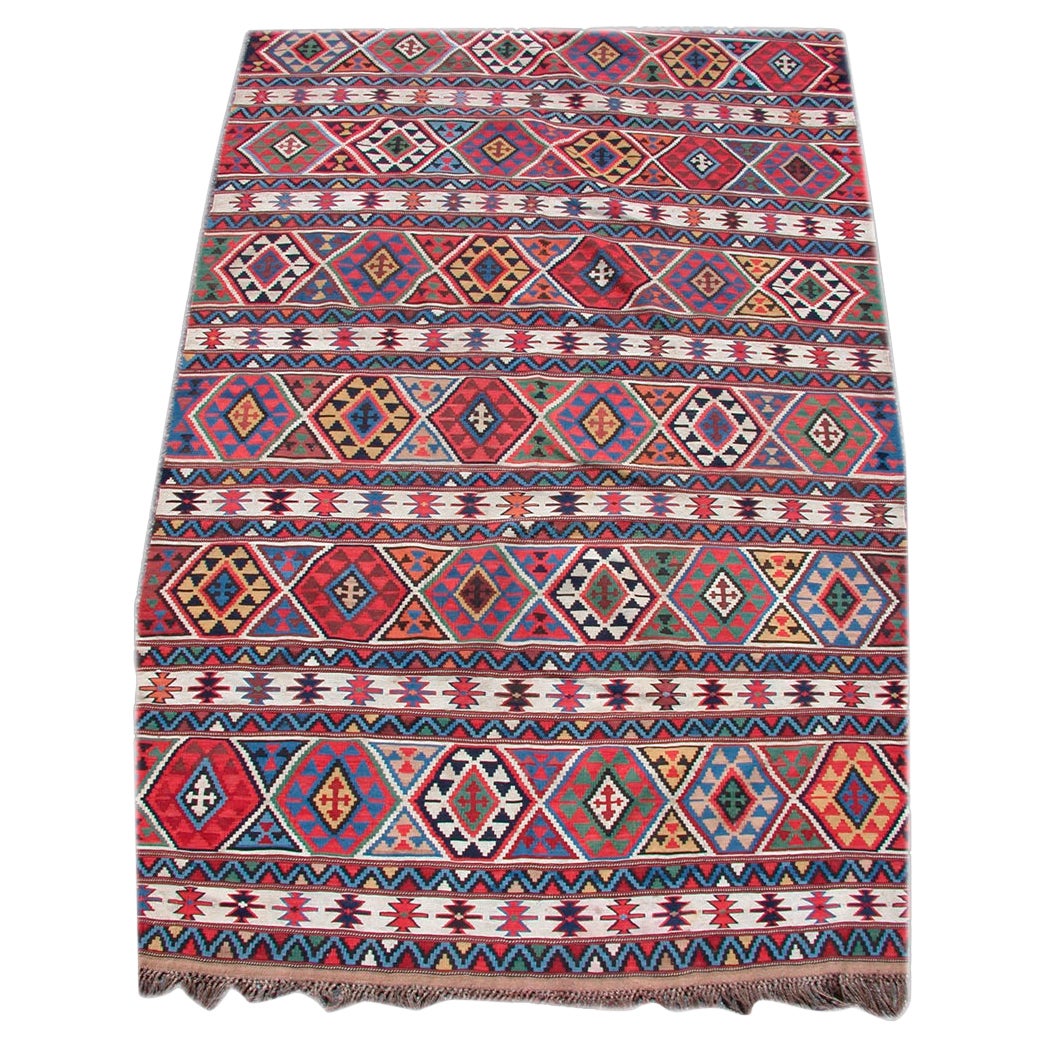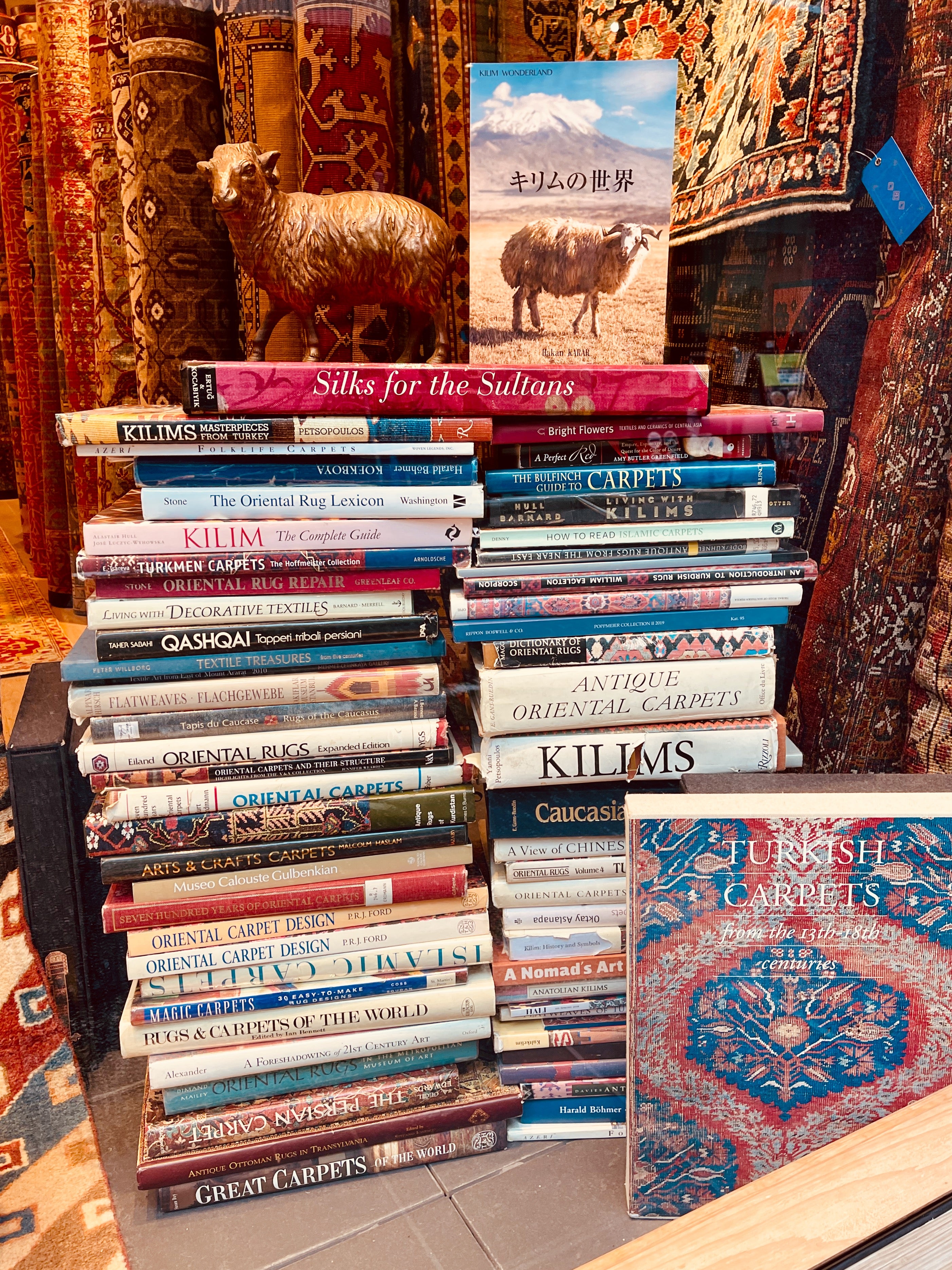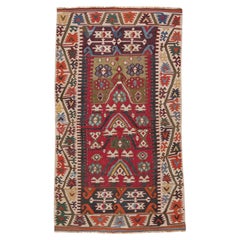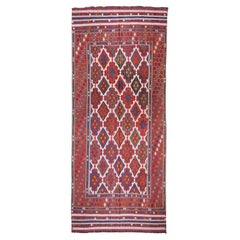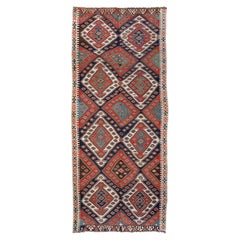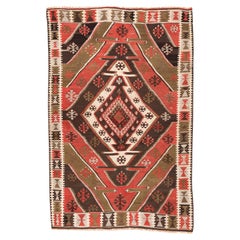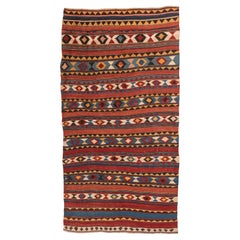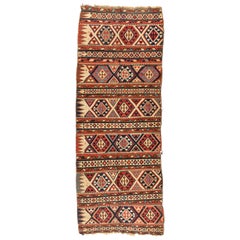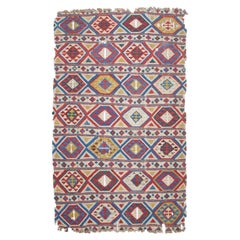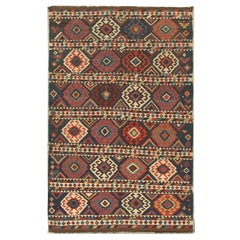Items Similar to Vintage Shirvan Kilim Rug, Handwoven Caucasian Old Carpet
Video Loading
Want more images or videos?
Request additional images or videos from the seller
1 of 6
Vintage Shirvan Kilim Rug, Handwoven Caucasian Old Carpet
$1,760
$2,20020% Off
£1,336.41
£1,670.5120% Off
€1,528.28
€1,910.3620% Off
CA$2,458.98
CA$3,073.7220% Off
A$2,734.92
A$3,418.6520% Off
CHF 1,428.09
CHF 1,785.1120% Off
MX$33,281.03
MX$41,601.2920% Off
NOK 18,238.87
NOK 22,798.5920% Off
SEK 17,104.85
SEK 21,381.0620% Off
DKK 11,406.17
DKK 14,257.7120% Off
Shipping
Retrieving quote...The 1stDibs Promise:
Authenticity Guarantee,
Money-Back Guarantee,
24-Hour Cancellation
About the Item
This is an old Shirvan Kilim from the Caucasus region with a rare and beautiful color composition.
Of the four countries that make up the Caucasus, Azerbaijan produces the most kilims, and the land has a long history of weaving. The nomadic tribes wove kilims and carpets as well as a wide range of storage bags and sacks, such as saffrash, khurgin and chula, and donkey and horse trappings. Smaller bags for salt, utensils, and other items are also common. Not only are the Azerbaijani weavers prolific, but they also employ many techniques at the loom. These include slitweave- known locally by the word kilim, warp-faced patterning (jajim), supplementary weft (zili), weft wrapping (popularly known as soumak), and extra weft wrapping (verneh). Furthermore, flatweaves are defined by regional names such as palas and shadda, so it is possible to ascribe a variety of weaving names to particular provenances as follows: soumaks are made in Kuba, palas, and kilims in Hajikabul, zili in Khizy, verneh and zili in Kazakh, shadda, verneh and zili in Barda, jajim in Agjabedi, and palas and kilims in Jabrail.
Shirvan Kilim is a kilim woven by farmers in the Shirvan plains in central Azerbaijan. This region is a mountainous region between the Caspian Sea and the Black Sea and is called the Caucasus region. In this isolated mountainous region where traditions have been preserved, there are many carpets, and the variety and number of kilims are very small, but the quality is highly evaluated in the world. Because there are few, it is a very valuable kilim. Such large, bold impressions are characteristic of the kilims of this region. The kilims of this region have such distinct characteristics that in the past it was possible to identify each production area by its pattern. Shirvan kilims in particular have horizontal stripes without borders like this one.
Best of all is the beauty of the deep shades and their contrast with the white of the cotton. Purple also has variations such as dark red, grape color, and deep purple, and blue also has variations such as dark blue, greenish blue, purplish blue, and ultramarine blue, and there are countless combinations with orange, pink, brown, and white. The precise and firm weaving shows a high level of skill. This kilim must have been carefully protected and woven.
- Dimensions:Width: 72.45 in (184 cm)Length: 131.89 in (335 cm)
- Style:Kilim (In the Style Of)
- Materials and Techniques:
- Place of Origin:
- Period:
- Date of Manufacture:circa 1970s
- Condition:Repaired: Minor repairs, with antique natural dyed wool threads by our repair specialists. Wear consistent with age and use. Minor fading.
- Seller Location:Tokyo, JP
- Reference Number:Seller: 200971stDibs: LU8206233438282
ARARAT RUGS
We know and believe that the geography we come from, our past, and our lifestyle are the most important bond between us to carry the oriental carpet art and culture to the next generations along with our core values in our ongoing growth journey.
We are aware that the way to achieve this goal and carry this priceless art and culture to the future depends on a lot of work with all our people every day while adhering to our core values.
For us, art is meaningful in the sense that it brings together various cultures around the world. It is an honor for us that oriental carpet art and culture have been instrumental in this for centuries and that we are a part of this business.
We are tirelessly keeping an eye on auction house information around the world about carpets. New York's Metropolitan, London's Victoria & Albert Museums, and other famous art museums, as well as small specialized museums that house private collections, and books about oriental carpets to collect information on outstanding carpet designs and patterns from around the world. It's our Self-improving and Self-developing culture.
As Turkish Culture of Hospitality, the Kurdish Culture of Generosity, and as Japanese Culture of Business Punctuality; are the most important values that this multicultural background has taught and bequeathed to us. It is essential and valuable for us that you feel this feeling not only by looking at our oriental carpets but from the moment you contact us.
About the Seller
5.0
Platinum Seller
Premium sellers with a 4.7+ rating and 24-hour response times
Established in 1970
1stDibs seller since 2023
55 sales on 1stDibs
Typical response time: 3 hours
- ShippingRetrieving quote...Shipping from: Tokyo, Japan
- Return Policy
Authenticity Guarantee
In the unlikely event there’s an issue with an item’s authenticity, contact us within 1 year for a full refund. DetailsMoney-Back Guarantee
If your item is not as described, is damaged in transit, or does not arrive, contact us within 7 days for a full refund. Details24-Hour Cancellation
You have a 24-hour grace period in which to reconsider your purchase, with no questions asked.Vetted Professional Sellers
Our world-class sellers must adhere to strict standards for service and quality, maintaining the integrity of our listings.Price-Match Guarantee
If you find that a seller listed the same item for a lower price elsewhere, we’ll match it.Trusted Global Delivery
Our best-in-class carrier network provides specialized shipping options worldwide, including custom delivery.More From This Seller
View AllAntique Aksaray Kilim Rug Wool Old Central Anatolian Handwoven Turkish Carpet
Located in Tokyo, JP
This is Central Anatolian Antique Kilim from the Aksaray region with a rare and beautiful color composition.
The beauty of the dyeing, the quality of the wool (thread), the splendor...
Category
Early 20th Century Turkish Kilim Turkish Rugs
Materials
Wool, Natural Fiber
Antique Caucasus Verneh Kilim Rug, Caucasian Carpet
Located in Tokyo, JP
This is a large Antique Verneh Kilim from the Caucasus region with a rare and beautiful color composition.
Of the four countries that make up the Caucasus, Azerbaijan produces the...
Category
Early 20th Century Caucasian Kilim Caucasian Rugs
Materials
Wool, Natural Fiber
Antique Rashwan Malatya Kilim Anatolia Rug Turkish Carpet
Located in Tokyo, JP
This is a Southern Anatolian Antique Rashwan Kilim from the Malatya region with a rare and beautiful color composition.
It is a large, 4 meters long Kilim with two halves attached...
Category
Early 20th Century Turkish Kilim Turkish Rugs
Materials
Wool, Natural Fiber, Organic Material
Rashwan Kayseri Kilim Rug Wool Old Vintage Eastern Anatolian Turkish Carpet
Located in Tokyo, JP
This is Eastern Anatolian Antique Rashwan Design Kilim, from the Kayseri region with a rare and beautiful color composition.
This highly collectible antique kilim has wonderful spec...
Category
Early 20th Century Turkish Kilim Turkish Rugs
Materials
Wool, Natural Fiber
Antique Malatya Kilim South Anatolia Runner Rug, Turkish Natural Carpet
Located in Tokyo, JP
This is a Southern Anatolian Antique Kilim from the Malatya region with a rare and beautiful color composition.
It was originally a kilim with two halves, but this is one half. Encountering such a piece is precious. Half of them are somewhere else in the world, or they are the survivors of Kilims who might otherwise have disappeared from this world due to special damage that is difficult to repair. Kilim is such an organic existence. That's why you can enjoy the encounter with your piece a once-in-a-lifetime chance.
As you can see at a glance, each color is a very beautiful kilim. You can enjoy the goodness of ablush from the deep red to the bright color close to orange. Dark blue, orange, khaki, and white complement each other, making each color more vivid. What makes it unique is the beauty of khaki. Also, the dark brown on the border that tightens all the colors is a modest presence, but I think it's very beautiful to change the expression.
Malatya is a town built on one main street that continues for several miles. It is situated in the Tohmasuyu River basin which is encircled by the high peaks of the eastern Taurus Mountains. This is a fertile agricultural region, particularly for apricots, and has been a prolific weaving area for many years. The modern town was established in 1838; old Malatya, which is close by, was once an important city in Armenia Minor. In Roman times it was important as a garrison town on the eastern frontier, and the settlement came under Ottoman rule in the early fifteenth century. Considering the number of kilims woven in this region there is a surprising lack of diversity in design, especially in the larger kilims; this is possibly a direct result of the Kurdish tribal tradition of weaving only one type of design. Small prayer rugs...
Category
Early 20th Century Turkish Kilim Turkish Rugs
Materials
Wool, Natural Fiber
Rashwan Malatya Kilim Rug Wool Old Vintage Eastern Anatolian Turkish Carpet
Located in Tokyo, JP
This is Eastern Anatolian Antique Kilim from the Rashwan, Malatya region with a rare and beautiful color composition.
This highly collectible antique kilim has wonderful special col...
Category
Mid-20th Century Turkish Kilim Turkish Rugs
Materials
Wool, Natural Fiber
You May Also Like
Old Shirvan Kilim from Caucasus
Located in Alessandria, Piemonte
Beautiful Shirvan kilim with classical colors and dense workmanship: a rug that You can put everywhere, also resting on a larger modern rug
(an idea !) - Its price is good for closi...
Category
Early 20th Century Caucasian Other Caucasian Rugs
Materials
Wool
Antique Shirvan Caucasian Kilim Flat Weave Rug, circa 1880s-1900s
Located in New York, NY
Kilim, a word of Turkish origin, denotes a pileless textile of many uses produced by one of several flat-weaving techniques that have a common or closely related heritage and are practiced in the geographical area that includes parts of Turkey (Anatolia and Thrace), North Africa, the Balkans, the Caucasus, Iran, Afghanistan, Pakistan, Central Asia and China.
Kilims are generally woven with the slitweave technique. The slit refers to the gap left between two blocks of color. It is created by returning the weft around the last warp in a color area, and the weft of the adjacent color is later returned around the adjacent warp.
The major difference between a kilim area rug and a carpet or a pile rug is that whereas the design visible on a pile rug is made by individual short strands of different color being knotted onto the warps and held together by pressing the wefts tightly, kilim designs are made by interweaving the variously colored wefts and warps, thus creating what is known as a flat-weave.
Weavers pack the weft tightly to completely cover the warp and often favor diagonal patterns so as to avoid weakening the structure of the rug with vertical slits. It produces bold, sharp patterns that weavers enjoy creating with more freedom allowed than a plainweave. This is also why kilims are so closely associated with geometrical designs even though there are kilims with floral designs as well.
This lovely antique Shirvan Caucasian Kilim...
Category
Antique 1880s Caucasian Kilim Caucasian Rugs
Materials
Wool
$2,240 Sale Price
20% Off
Antique Caucasian Shirvan Kilim, Late 19th Century
Located in San Francisco, CA
Antique Shirvan Kilim Rug, Late 19th Century
Additional Information:
Dimensions: 7'9" L x 4'7" W
Origin: Caucasus
Period: Late 19th Century
Rug ID: 15220
Category
Antique Late 19th Century Caucasian Caucasian Rugs
Materials
Wool
Antique Caucasian Shirvan Kilim Rug 5'5 x 9'10
Located in New York, NY
Antique Caucasian Shirvan Kilim Rug 5'5 x 9'10. This is a Shirvan Kilim long rug with a pattern of wide navy horizontal rows of stepped hexagons enclosing smaller, similar hooked devices. Instead of wide and somewhat narrower bands alternating, the latter have shrunk to thinner ivory lines with stepped crosses as ornaments. Terra cotta, ivory, medium blue, yellow-tan and brown-lack are among the salient tones of this slit tapestry carpet with a generally more restrained palette. At the ends of the broad sections are amusing geometric fillers. The general tonality extends to the dark grey-brown barber pole warps. In their country of origin, these kilims had multiple functions: floor coverings, room dividers, wall decorations, cart covers, indeed any place where a durable, colorful larger scale textile...
Category
Antique 19th Century Caucasian Caucasian Rugs
Materials
Wool
Antique Shirvan Kilim, Late 19th Century
Located in San Francisco, CA
Antique Shirvan Kilim Rug, Late 19th Century
Additional Information:
Dimensions: 5'2" W x 11'2" L
Origin: Caucasus
Period: Late 19th Century
Category
Antique Late 19th Century Caucasian Caucasian Rugs
Materials
Wool
Antique Caucasian Shirvan Kilim, 19th Century
Located in San Francisco, CA
Antique Caucasian Shirvan Kilim Rug, 19th Century
Additional Information:
Dimensions: 5'10" x 11'1"
Origin: Caucasus
Period: 19th Century (4th Quarter)
Rug ID: 13519
Category
Antique 19th Century Caucasian Caucasian Rugs
Materials
Wool
More Ways To Browse
Horse Carpet
Old World Weavers
Vintage Sea Horse
Old Utensils
Vintage Grape Pattern
Kilim Storage
Blue Rug Horse
Kazakh Rug
Blue Donkey
Large Soumak Rug
Seichour Kuba Rugs
Lambalo Kazak
Dragon Sumac
1950 Leather Chair
Gold Carved Table
Vintage Square Carpet
Scandinavian Upholstery Fabric
Metal Mid Century Modern Coffee Table
